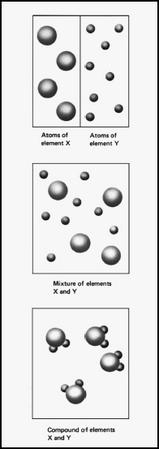Compounds - How it works
Elements and Compounds
A compound is a substance made up of atoms representing more than one element, and these atoms are typically joined in molecules. The composition of a compound is always the same: for instance, water always contains molecules composed of two hydrogen atoms bonded to a single oxygen atom. It can be frozen or boiled, but the molecules themselves are unchanged, because freezing and boiling are merely physical processes. To transform one compound into another, on the other hand, requires a chemical change or reaction.
Likewise, a chemical change is required to break down a compound into its constituent elements. Water can be broken down by passing a powerful electric current through it. This process, known as electrolysis, separates water into hydrogen and oxygen, both of which are highly flammable gases. The fact that they can be joined to form water, a substance used for putting out most kinds of fires, illustrates the types of changes elements undergo when they join to form compounds.
The atoms in a compound do not change into other atoms; or to put it another way, the elements do not change into other elements. Though two hydrogen atoms bond with an oxygen atom to form water, they are still hydrogens, and the oxygen is still an oxygen. The atoms' elemental identity thus remains intact, and if these elements are separated, they can join with other elements to form entirely different compounds.
Letters and Elements; Words and Compounds
The nature of a compound is almost paradoxical: the constituent elements remain the same, yet the compound typically bears little resemblance to the elements that form it. How can this be? Perhaps an analogy to language, and the symbols used to express it, will serve to show that this

There are between 88 and 92 elements that appear in nature; figures vary, because a handful of the elements with atomic numbers less than 92 have not actually been found in nature, but were produced in laboratories. (All elements with an atomic number higher than that of uranium, which is 92, are artificial.) In any case, there are far more elements than there are letters in the English alphabet; yet even with 26 characters, it is possible to form an almost limitless vocabulary.
Let us focus on a single letter, g. Phonetically, it can make a hard sound, as in great, or a soft one, as in geranium. It may be silent, as in light, or it may combine with another letter to make either a typical "g" sound (edge) or a totally unexpected one (rough). It can slide into a vowel sound smoothly, as in singer, or with an almost imperceptible pause, as in finger. The complexities multiply when we consider the range of possibilities for the letter g , and all the resultant meanings involved: from God to dog, or from glory to degeneration.
WHAT THIS ANALOGY SHOWS ABOUT CHEMISTRY.
One could go on endlessly in this vein, and all with just one letter; however, a few points need to be made regarding the analogy between letters of the alphabet and elements. First of all, in all of the examples given above, or any number of others, the g still remained a g. In the same way, an atom of hydrogen (another g-word!) is always a hydrogen, whether it combines with oxygen to form water, nitrogen to make ammonia, or carbon to produce petroleum.
Secondly, note that this illustration would have been more difficult if the letter chosen had been q or z , since these are used more rarely. Likewise, there are elements such as technetium or praseodymium that seldom come up in discussions of compounds. On the other hand, one cannot go far in the study of chemistry without running across compounds involving hydrogen, carbon, oxygen, nitrogen, various metals, or halogens such as fluorine.
A third point to consider is the fact that there is nothing about g itself that provides any information as to the meaning of the word it helps to form. Here the analogy to elements is imperfect, because the nature of the element's subatomic structure—particularly the configuration of electrons on the outer shell of the atom— provides a great deal of information as to how it will combine with other atoms.
Still, it is evident, as we have seen, that the properties of a compound cannot easily be predicted by studying the properties of its constituent elements—just as one cannot begin to define a word simply because it contains a g. On the other hand, knowledge of the sounds that g makes may help us to pronounce a word containing that letter. In the same way, the fact that a compound includes carbon provides a clue that the compound might be organic.
Even when we have all the letters to form a word, we still need to know how they are ordered. Loge and ogle contain the same letters, but one is a noun referring to a theater box, whereas the other is a verb meaning the act of looking at someone in an improper fashion. In chemistry, these are called isomers: two substances having identical chemical formulas, but differing chemical structures.
It so happens that g is also part of the suffix -ing, used in forming a gerund. Aside from being yet another g -word, a gerund is a substantive, or noun form of a verb: for instance, going. Once again, there is a similarity between words and compounds. Just as certain classes of words are formed by the addition of regular suffixes, so the naming of whole classes of compounds can be achieved by means of a uniform system of nomenclature.
Comment about this article, ask questions, or add new information about this topic: